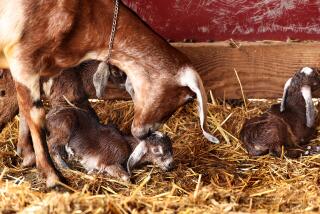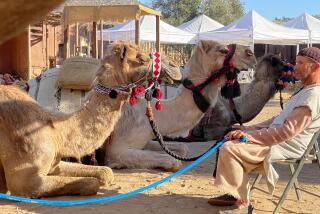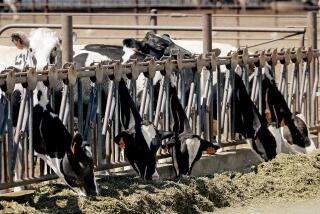A Fair Job of Milking a Camel
How many people does it take to milk a camel?
Gil Riegler, owner of Oasis Camel Dairy, can answer that. Two--one to actually milk the camel and the other to distract its calf, which must be present for the camel to drop her milk.
“Milking a camel is very tricky,” he said.
Riegler, 41, who lives with fiancee Nancy Kobert and 12 camels in Ramona, demonstrates the proper technique several times a day at the Los Angeles County Fair in Pomona.
Many factors make milking a camel tougher than milking a cow, or even a goat, said Riegler.
First is the requisite speed. “Because camels are nomadic, they only drop their milk for about 90 seconds, probably so the female is able to keep up with the herd,” he said.
Second is the presence of the camel’s calf. Unlike cows, camels won’t give milk unless their teats are stimulated by their offspring.
“As soon as the milk is there, you push the baby out of the way--he gets some grain--and then you milk as fast as you can for 90 seconds,” said Riegler, displaying a pail full of frothy white camel’s milk.
In Middle Eastern deserts that are the one-hump dromedary’s natural habitat, nomads who keep camels can get about two liters of milk a day, he said. “We’ve been combining a lot of techniques from around the world, and we can get up to 12 liters.”
Riegler began working with camels about a decade ago, while training animals as part of a program for the disabled that offered riding and other activities.
He discovered that if treated properly, camels weren’t nasty and rarely spit. Riegler studied dromedary husbandry in Israel, which has camel dairies as do other Middle Eastern nations.
At this stage, the Oasis Camel Dairy is more idea than working dairy. Tuesday, when two dozen of the curious gathered in front of the exhibit to see Goldie milked, Riegler told them, “We can’t let you taste it yet, because the FDA would be very angry with us.”
He hopes to have the dairy up and running, and blessed by the Food and Drug Administration, by the end of next year. He already has the stock (females like Goldie cost about $8,000) and plans to build facilities on a 34-acre spread near Escondido.
Riegler figures he’s $70,000 away from selling ice-cold bottles of camel’s milk. Meanwhile, he shares the milk, and the occasional batch of homemade camel cream cheese, with his friends.
Esther Murphy, an exotic-animal trainer, who is helping Riegler show the animals at the fair, gushes about Goldie’s milk.
“It tastes just like cow’s milk to me, except it’s a little sweeter and lighter,” said Murphy, 29. “On top of that, it’s better for you. It’s lower in fat.... It’s lower in sugar, higher in protein and has about triple the amount of vitamin C.”
Julie Dantonoli, 46, of Garden Grove sought out the camel dairy exhibit because she had heard that dromedary milk was low in fat and highly nutritious.
“It’s going to be, like, the perfect food,” she said. “I was thinking of raising llamas, but I might try a couple of camels instead.”
For now, the Oasis Camel Dairy is only marketing one product, camel milk soap. There are six varieties, including one called Gold, Frankincense & Myrrh.
“That’s the one that people buy for stocking stuffers,” Murphy said.
*
Fair Hours
Los Angeles County Fair, Fairplex, 1101 W. McKinley Ave., Pomona. Fridays, 11 a.m. to midnight; Saturdays, 10 a.m. to midnight; Sundays, 10 a.m. to 10 p.m.; Mondays through Thursdays, 11 a.m. to 10 p.m. Through Sept. 29. Admission, $4 to $35; children 5 and younger admitted free. Some events have additional admission charges of $12.50 to $50. (909) 623-3111.
www.lacountyfair.com.
More to Read
Sign up for Essential California
The most important California stories and recommendations in your inbox every morning.
You may occasionally receive promotional content from the Los Angeles Times.










